soil
tilth
Soil texture, structure, and organic matter content create the physical environment, tilth, needed for healthy plant roots. Because plants are part of the larger soil ecosystem, good tilth also requires adequate fertility and a balanced population of soil organisms.
Good tilth enables roots to expand freely and facilitates absorption of water, oxygen, and nutrients. Well-structured soil is also water-efficient: less applied water is needed to reach plant roots and runoff is reduced because water is absorbed faster and held better. “Moist but well-drained” is the common description of a well-structured soil, which acts like a sponge because it has a similar porous composition:
Pores
A good soil contains a network of pores that occupy 50% of its volume. Pores range in diameter from microscopic to over 0.05 mm. When fully charged with water, the pore space in a good soil will be roughly half-filled with air and half with water.
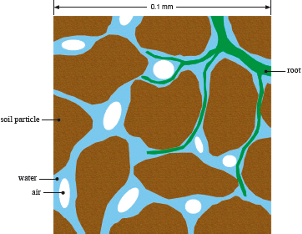 Stevens Water Monitoring Systems Unsaturated soil pore space
Stevens Water Monitoring Systems Unsaturated soil pore space
Solids
The solid fraction of a good soil is about 45% mineral particles and 5% decomposed organic material by volume. While organic matter is not high on a percentage basis, it is critical in holding soil particles together, storing nutrients, and feeding soil organisms.
 PhysicalGeography.net Complexity of average soil
PhysicalGeography.net Complexity of average soil
Different types of soil have different compositions:
 Figure based on data from Cornell University in Soil hydrology and subsequent sections
Figure based on data from Cornell University in Soil hydrology and subsequent sections
Texture
Texture describes the coarseness/fineness of the mineral component of soil and reflects both the sizes of the mineral particles and their relative abundances. Texture is described as sand, silt or clay.
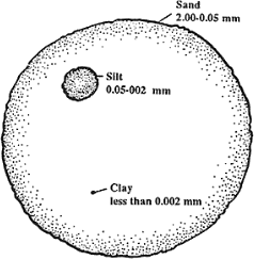 U of Hawaii Soil Minerals
U of Hawaii Soil Minerals
Texture affects two fundamental soil properties that are critical for plant health:
- the surface area of the inorganic, mineral component, which determines the capacity for most soil activities such as nutrient binding as well as the strength of binding
- soil pore space, which determines permeability to water, air, and roots. Via the effect on pore space, texture affects gross water handling characteristics such as percolation and leaching.
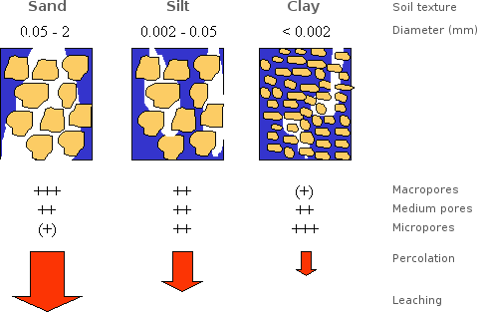 U. of Wisconsin Soil Morphology
U. of Wisconsin Soil Morphology
Sand
Sand is comprised of large, round particles that pack poorly and give the soil a gritty feel. It is easy to cultivate and its open structure readily admits air and water. However, because sand particles have a low surface area:volume ratio, sand retains water and nutrients poorly.
Coarse, builder’s sand can increase the large pore spaces where bulk drainage occurs and air and roots reside, but the volume required is prohibitive — soil must contain 50% medium-coarse sand before drainage begins to improve. Soils must contain at least 80% sand particles to become sands.
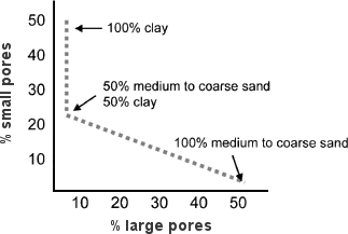 modified from CO Master Gardeners Managing Soil Tilth: Texture, Structure, and Pore Space
modified from CO Master Gardeners Managing Soil Tilth: Texture, Structure, and Pore Space
Silt
Silt particles are round and microscopic–visible in size. Silt feels floury when dry but slick when wet. Silt soils have a moderate surface area:volume ratio and have little effect on soil texture. Soils must contain at least 88% silt particles to become silts.
Clay
Clay is comprised of submicroscopic, flat, plate-like particles that pack tightly. It is hard when dry but sticky and plastic when wet. The non-porous structure impedes root, air, and water penetration. However, because clay has a very high surface area:volume ratio, it is often rich in nutrients and retains added nutrients well. Due to its large surface area, clay has a dominant influence on soil texture — soils that contain more than 40% clay particles are clays. Compacted clay soil is typical for many residential lots.
Loam
Nearly all soils contain a mixture of sand, silt, and clay. When a soil contains significant proportions of at least two particle types, it is classified as a loam. Loams, in turn, are subclassified by the relative amounts of each texture.
Orange County contains mostly clay loams and silty clay loams. However, soil type can vary widely, even within a single garden.
| Loam | Sand | Silt | Clay |
|---|---|---|---|
| Classic | 50–72 | 28–50 | 7–27 |
| Orange County | 0–46 | 5–73 | 27–40 |
Classic loams
Classic loam soils, which are mostly sand and silt, are the ideal texture for gardening but still need organic matter to achieve optimal soil structure. They have a good balance of macropores and micropores, and have good water holding capacity and permeability.
Sandy loams
These have a higher percentage of sand than a classic loam and generally have a lower water holding capacity and higher permeability.
Silty loams
These soils have a higher percentage of silt than a classic loam. They have a higher water holding capacity, but drain less well.
Clay loams
These soils are typical of Orange County. They have a higher percentage of clay than a classic loam and behave like a clay soil. They are hard when dry and sticky when wet, have a very high water retaining capacity and very poor permeability. They tend to be the most difficult to work with because they are dense, poorly drained, and poorly aerated.
Ways to determine texture
USDA soil texture triangle
 Master Gardeners of Grays Harbor & Pacific Counties, WA Soils
Master Gardeners of Grays Harbor & Pacific Counties, WA Soils
NRCS-USDA soil maps
The detailed NRCS-USDA soil maps maps are an excellent way to find texture and much additional information about the native soil on your property. See Soil Maps for user-friendly instructions. However, because your property may have been altered significantly during home construction or by prior use (e.g. for pasture or crops), we recommend submitting samples to the Extension office for a free soil test.
Field test
You can perform a simple in-home field test to determine texture:
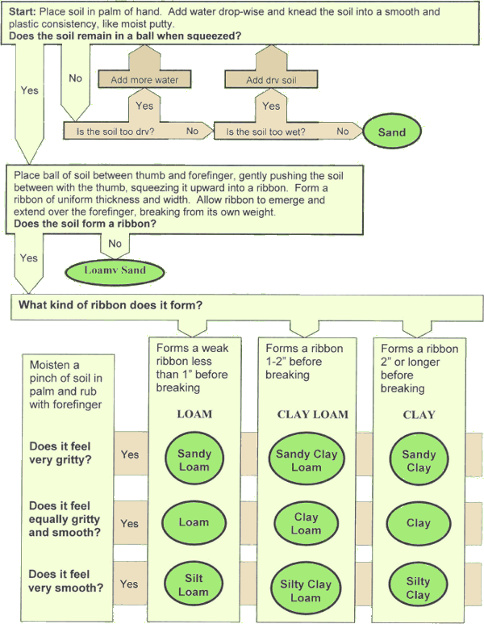 CO Master Gardeners Estimating Soil Texture: Sand, Silt or Clayey?
CO Master Gardeners Estimating Soil Texture: Sand, Silt or Clayey?
Pores
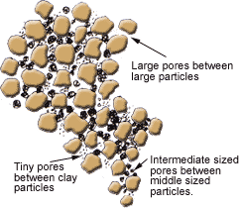 Commonwealth of Australia Soil Structure: pore spaces
Commonwealth of Australia Soil Structure: pore spaces
The pore network delivers water, oxygen, and nutrients to roots, which also live in the network. In a good soil, the pore space contains a balance of large and small channels such that about 50% is occupied by air and the other 50% by water. After a heavy application of water, all of the pores can fill temporarily without harm to plants. However, if the pores remain full due to environmental conditions like continuous heavy rain or structural issues preventing drainage like hardpan beneath the surface or soil compaction, then roots will be deprived of oxygen and suffocate. In heavy clay, raised beds or installation of subsurface drainage may be needed.
| Pore diameter, µm | Pore properties |
|---|---|
| 4000 | an earthworm channel (4mm) |
| 300 | diameter of a grass root |
| 60–30 | smallest pore that will be air-filled at field capacity |
| 10 | a fungal hypha |
| 2 | a bacterial cell or the largest clay particle, smallest pore from which a plant can readily obtain water |
| 0.2 | smallest pore that will give up water to the suction exerted by a plant root, the pore size corresponding to the permanent wilting point |
| 0.003 | largest pore filled with water in an ‘air dry’ soil, ~ 10X the diameter of a water molecule |
Pore size creates different classes of soil water
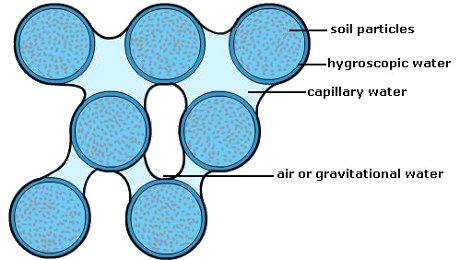 TutorVista.com Sources of water
TutorVista.com Sources of water
Gravitational water
- Transmission pores (very large, 30–60 micron)
- ~ 30% of the pore space in a good soil
- These pores act as drainage channels because gravitational force exceeds surface tension and water drains away. Gravitational water is not available for plant uptake. Transmission pores are critical for bulk drainage, root growth, and air movement.
Plant-available water
- Storage pores (medium, 0.2–30 micron)
- ~ 40% of the pore space in a good soil
- These pores act as water reservoirs because the surface tension in medium cavities is greater than the force of gravity so that water is held in place, yet water is still held loosely enough for plant uptake.
Unavailable water
- Residual pores (very small, ‹0.2 micron)
- ~ 30% of the pore space in a good soil
- These pores contain water that cannot be used by plants because the surface tension in small cavities holds the water too tightly for plant extraction. Unavailable water comprises much of the pore space in compacted clay soil.
Structure
Soil structure refers to the grouping of soil components (the mineral component, organic matter, and fertilizers) into porous compounds called aggregates, which are then arranged into larger units called peds, separated by pores and cracks.
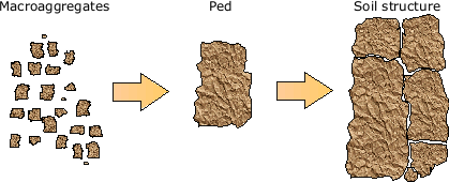 modified from New Zealand Soils Soil structure: Peds & the types of structural units
modified from New Zealand Soils Soil structure: Peds & the types of structural units
Soil structure, particularly at the macroaggregate level, is affected by how you garden. Good technique and the use of remedial methods can create a structure that has good infiltration and percolation properties.
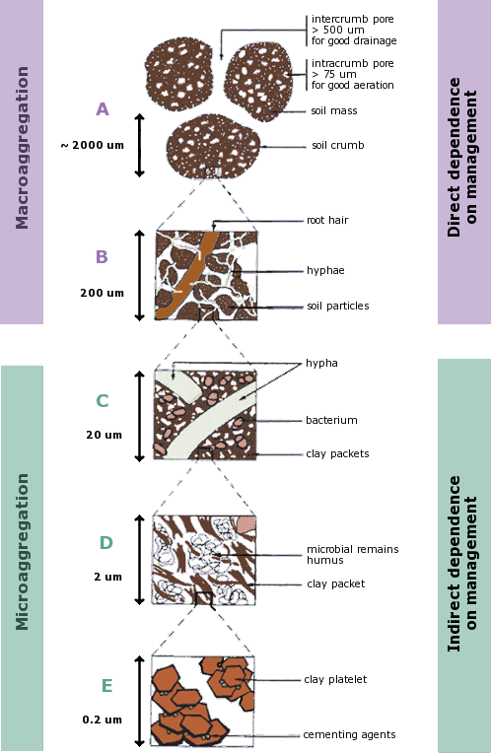 State of Victoria, Australia Principal Binding Agents
State of Victoria, Australia Principal Binding Agents
| Level | Principal binding agents | Persistence |
|---|---|---|
| B | plant roots, fungal hyphae | short–medium |
| C | decayed roots and fungal hyphae | longer |
| D | microbial remains and humus | longer |
| E | adsorbed humic substances, hydrous oxides | very long |
Floccules
At the first level of structure, polyvalent cations (elements with multiple positive charges) such as calcium, magnesium, iron, and aluminum act as molecular bridges to bind and neutralize the mutually repulsive negative charges on clay particles. Aggregation begins with the formation of microscopic clumps called floccules.
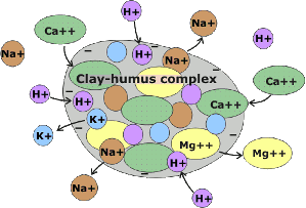 U Wisconsin Soil characteristics
U Wisconsin Soil characteristics
Primary aggregates
At the next level of structure, polyvalent cations create bridges between humus molecules (negatively charged, relatively stable molecules resulting from the breakdown of compost) and clay floccules. The clay-humus particles then bind to each other and to grains of silt to form the smallest of the primary aggregates.
Peds
Next, polyvalent cations such as calcium act with organic molecules to promote initial aggregation of primary aggregates into slightly larger microaggregates comprised of fine or very fine sand grains, smaller clumps of silt grains, clay, and organic debris. Root hairs, fungal hyphae, and root exudates (organic carbohydrate ‘glues’) help to stabilize the microaggregates and to assist in formation of peds.
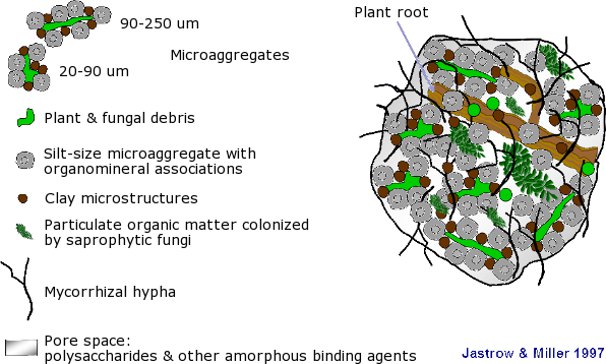
Granular peds
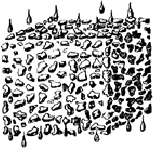 Rapid flow
Rapid flow
Granular peds are small and generally spherical in shape with irregular faces. Because the outer surfaces do not fit well together, they pack poorly and create optimal channels for water penetration. Granular structure is most commonly found in surface soils, especially those enriched with organic matter. Grassland vegetation and earthworm activity encourage granular structure.
Blocky peds
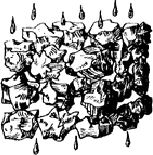 Moderate flow
Moderate flow
Blocky peds are cube-like in that all dimensions are of nearly equal length. Peds are not formed individually, but take their shape from surrounding peds. Blocky structure is subdivided into subangular blocky (sbk), where most of the edges are somewhat rounded, and angular blocky (abk) where edges are sharp and well-defined. Sbk peds are larger than granular peds but, because of similar poor packing, provide good water infiltration. Abk peds pack more tightly and are less permissive for infiltration. Blocky structures are common in subsoil but also occur in surface soils that have a high clay content.
Prismatic peds
 Moderate flow
Moderate flow
Prismatic peds are longer than they are wide. Similar to blocky peds, they take their shape from surrounding peds. The vertical cracks result from freeze-thaw and wet-dry cycles (prisms are often associated with swelling types of clays) as well as the downward movement of water and roots. While the infiltration rate is similar to that of blocky structure, water delivery to plant roots is generally poor due to the lack of horizontal channels. Prismatic peds are commonly found in subsoils.
Platy peds
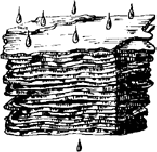 Slow flow
Slow flow
Platy peds are small, thin, and horizontally-oriented, like plates stacked one on top of another. Platy structure may occur naturally in surface or subsoil as a product of soil formation or development, but is especially common in subsoils that have been subject to leaching or to compaction by animals or machinery. Tight ped packing in conjunction with the large overlapping horizontal ped surfaces creates small, highly tortuous channels. Infiltration rate is slow and penetration depth is poor.
Images source: Colorado Master Gardeners Managing Soil Tilth: Texture, Structure & Pore Space
Summary
The graph summarizes the effects of texture, organic matter, and structure on effective soil pore space (pores that hold plant-available water). Organic matter acts primarily by altering ped type. Clay can either maximize or minimize effective pore space, depending on how much organic matter (% o.m.) is present.
 Cooperative Soil Survey (U of Missouri/NRCS) Soil Structure — Physical Properties
Cooperative Soil Survey (U of Missouri/NRCS) Soil Structure — Physical Properties
